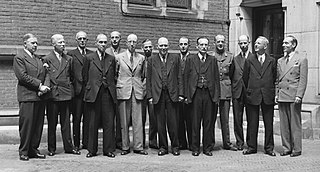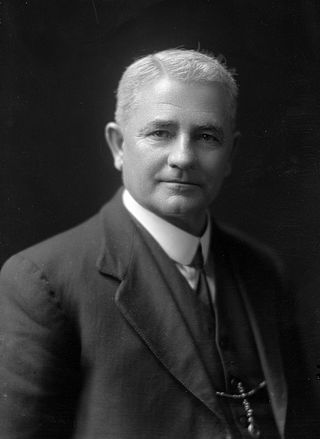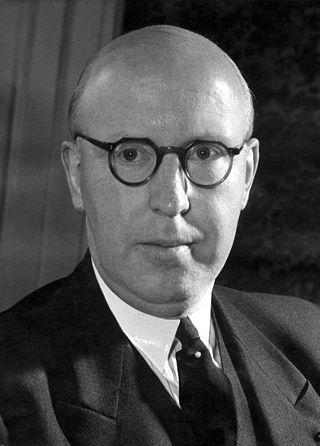The Labour Party is a social-democratic political party in the Netherlands.

Willem Drees Sr. was a Dutch politician of the Social Democratic Workers' Party (SDAP) and later co-founder of the Labour Party (PvdA) and historian who served as Prime Minister of the Netherlands from 7 August 1948 to 22 December 1958.
The social market economy, also called Rhine capitalism, Rhine-Alpine capitalism, the Rhenish model, and social capitalism, is a socioeconomic model combining a free-market capitalist economic system alongside social policies and enough regulation to establish both fair competition within the market and generally a welfare state. It is sometimes classified as a regulated market economy.

The Free-thinking Democratic League was a progressive liberal political party in the Netherlands. Established in 1901, it played a relatively large role in Dutch politics, supplying one Prime Minister, Wim Schermerhorn. The League is a predecessor of two of the major Dutch political parties, the conservative liberal People's Party for Freedom and Democracy (VVD) and the social democratic Labour Party (PvdA). The social liberal Democrats 66 also claims that it and the VDB are ideologically connected.
The polder model is a method of consensus decision-making, based on the Dutch version of consensus-based economic and social policymaking in the 1980s and 1990s. It gets its name from the Dutch word (polder) for tracts of land enclosed by dikes.

The Schermerhorn–Drees cabinet was the executive branch of the Dutch Government from 25 June 1945 until 3 July 1946. The cabinet was formed by the christian-democratic Roman Catholic State Party (RKSP), the social-democratic Social Democratic Workers' Party (SDAP) and the social-liberal Free-thinking Democratic League (VDB) by royal decree following the end of World War II. The cabinet was a provisional centre-left grand coalition and had a substantial majority in the House of Representatives, with prominent civil engineer Willem Schermerhorn of the Free-thinking Democratic League serving as Prime Minister. Social Democratic Leader Willem Drees served as Deputy Prime Minister and Minister of Social Affairs.

Henry Edmund Holland was an Australian-born newspaper owner, politician and unionist who relocated to New Zealand. He was the second leader of the New Zealand Labour Party.

The Roman Catholic State Party was a Catholic Christian democratic political party in the Netherlands. The party was founded in 1926 as a continuation of the General League of Roman Catholic Caucuses. During its entire existence, the party was in government. In 1945 the party became the Catholic People's Party (KVP).

The Social Democratic Workers' Party was a Dutch socialist political party existing from 1894 to 1946, and a predecessor of the social democratic Labour Party.
This article gives an overview of socialism in the Netherlands, including communism and social democracy. It is limited to communist, socialist, social democratic, and democratic socialist parties with substantial support, mainly proved by having had a representation in parliament. The sign ⇒ means a reference to another party in that scheme.

The National Labor Secretariat was a trade union federation in the Netherlands from 1893 to 1940.

Jacobus Albertus Wilhelmus "Jaap" Burger was a Dutch politician of the Social Democratic Workers' Party (SDAP) and later co-founder of the Labour Party (PvdA) and jurist. He was granted the honorary title of Minister of State on 4 January 1975.

Pieter "Piet" Lieftinck (30 September 1902 – 9 July 1989) was a Dutch politician of the Christian Historical Union (CHU) party and later the Labour Party (PvdA) and economist.

Hendrik "Hein" Vos was a Dutch politician of the defunct Social Democratic Workers' Party (SDAP) and later the Labour Party (PvdA) and economist.

The Labour Plan, commonly known as the Plan De Man after its creator, was an economic policy devised in 1933 by the Belgian politician Henri De Man of the Belgian Labour Party (POB-BWP), to combat the economic situation experienced by Belgium in the aftermath of the Great Depression. The plan, described as a "Labour Plan", was one of the foremost examples of De Man's doctrine of "Planisme". The policy was aimed at "instilling a mixed economic system" by the creation of "a nationalized sector covering the organization of credit and the main industries which have already in reality been monopolized."

Amma Asentewaa Asante is a Dutch politician. She was a member of the municipal council of Amsterdam from 1998 to 2006 and a member of the House of Representatives of the Netherlands for the Labour Party from 2016 to 2017.

Roosje Vos was a Dutch seamstress who became an activist in the push for labor protections of working women. Founding trade unions and editing journals, she advocated for suffrage, women's economic independence and an eight-hour work day. An active member of the socialist party and later the communist party, she ran for election to the Groningen Provincial Council and served from 1919–1927.

Willem Banning was a Dutch theologian, philosopher, sociologist and politician, who played an important role in Dutch 20th-century politics.
Anarchism in the Netherlands originated in the second half of the 19th century. Its roots lay in the radical and revolutionary ideologies of the labor movement, in anti-authoritarian socialism, the free thinkers and in numerous associations and organizations striving for a libertarian form of society. During the First World War, individuals and groups of syndicalists and anarchists of various currents worked together for conscientious objection and against government policies. The common resistance was directed against imperialism and militarism.

Nancy Sophie Cornélie "Corry" Tendeloo was a Dutch lawyer, feminist, and politician who served in the House of Representatives for the Free-thinking Democratic League (VDB) from 1945 until 1946 and then for the newly-formed Labour Party (PvdA) until her death in 1956. Born in the Dutch East Indies, Tendeloo studied law at Utrecht University, during which time she made contact with people within the women's rights movement. She became politically active in the 1930's and was elected to the Amsterdam City Council for the VDB in 1938. After World War II, Tendeloo was appointed a member of the House of Representatives for the VDB in the national emergency parliament, formed to rebuild the country and organise elections. In 1946, the VDB merged with other parties into the PvdA, which Tendeloo represented in parliament. She sat on two select committees and spoke in favour of women's rights issues.















